统一流控服务开源:基于.Net Core的流控服务
先前有一篇博文,梳理了流控服务的场景、业界做法和常用算法
最近完成了流控服务的开发,并在生产系统进行了大半年的验证,稳定可靠。今天整理一下核心设计和实现思路,开源到Github上,分享给大家

https://github.com/zhouguoqing/FlowControl
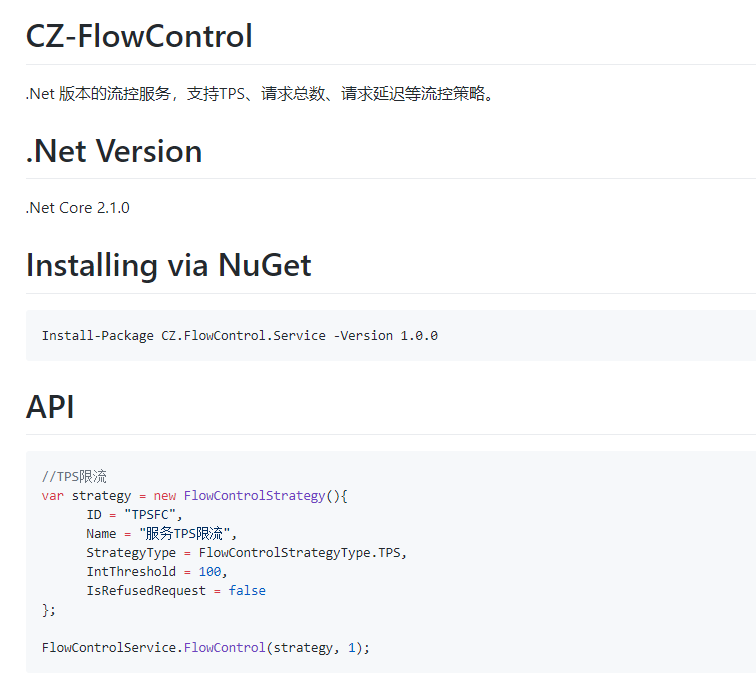
一、令牌桶算法实现
先回顾一下令牌桶算法示意图
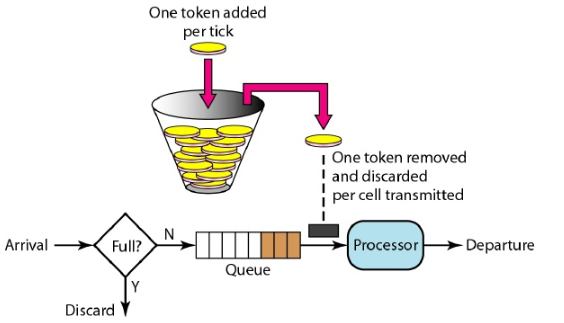
随着时间流逝,系统会按恒定1/QPS时间间隔(如果QPS=100,则间隔是10ms) 往桶里加入Token(想象和漏洞漏水相反,有个水龙头在不断的加水),
如果桶已经满了就不再加了. 新请求来临时, 会各自拿走一个Token,如果没有Token可拿了就阻塞或者拒绝服务.
令牌添加速度支持动态变化,实时控制处理的速率.
令牌桶有两个关键的属性:令牌桶容量(大小)和时间间隔,
有两个关键操作,从令牌桶中取Token;令牌桶定时的Reset重置。
我们看TokenBucket类:
using System; namespace CZ.FlowControl.Service { using CZ.FlowControl.Spi; /// <summary> /// 令牌桶 /// </summary> public abstract class TokenBucket : IThrottleStrategy { protected long bucketTokenCapacity; private static readonly object syncRoot = new object(); protected readonly long ticksRefillInterval; protected long nextRefillTime; //number of tokens in the bucket protected long tokens; protected TokenBucket(long bucketTokenCapacity, long refillInterval, long refillIntervalInMilliSeconds) { if (bucketTokenCapacity <= 0) throw new ArgumentOutOfRangeException("bucketTokenCapacity", "bucket token capacity can not be negative"); if (refillInterval < 0) throw new ArgumentOutOfRangeException("refillInterval", "Refill interval cannot be negative"); if (refillIntervalInMilliSeconds <= 0) throw new ArgumentOutOfRangeException("refillIntervalInMilliSeconds", "Refill interval in milliseconds cannot be negative"); this.bucketTokenCapacity = bucketTokenCapacity; ticksRefillInterval = TimeSpan.FromMilliseconds(refillInterval * refillIntervalInMilliSeconds).Ticks; } /// <summary> /// 是否流控 /// </summary> /// <param name="n"></param> /// <returns></returns> public bool ShouldThrottle(long n = 1) { TimeSpan waitTime; return ShouldThrottle(n, out waitTime); } public bool ShouldThrottle(long n, out TimeSpan waitTime) { if (n <= 0) throw new ArgumentOutOfRangeException("n", "Should be positive integer"); lock (syncRoot) { UpdateTokens(); if (tokens < n) { var timeToIntervalEnd = nextRefillTime - SystemTime.UtcNow.Ticks; if (timeToIntervalEnd < 0) return ShouldThrottle(n, out waitTime); waitTime = TimeSpan.FromTicks(timeToIntervalEnd); return true; } tokens -= n; waitTime = TimeSpan.Zero; return false; } } /// <summary> /// 更新令牌 /// </summary> protected abstract void UpdateTokens(); public bool ShouldThrottle(out TimeSpan waitTime) { return ShouldThrottle(1, out waitTime); } public long CurrentTokenCount { get { lock (syncRoot) { UpdateTokens(); return tokens; } } } } }
这个抽象类中,将UpdateToken作为抽象方法暴露出来,给实现类更多的灵活去控制令牌桶重置操作。基于此实现了“固定令牌桶”FixedTokenBucket
/// <summary> /// 固定令牌桶 /// </summary> class FixedTokenBucket : TokenBucket { public FixedTokenBucket(long maxTokens, long refillInterval, long refillIntervalInMilliSeconds) : base(maxTokens, refillInterval, refillIntervalInMilliSeconds) { } protected override void UpdateTokens() { var currentTime = SystemTime.UtcNow.Ticks; if (currentTime < nextRefillTime) return; tokens = bucketTokenCapacity; nextRefillTime = currentTime + ticksRefillInterval; } }
固定令牌桶在每次取Token时,都要执行方法ShouldThrottle。这个方法中:
并发取Token是线程安全的,这个地方用了Lock控制,损失了一部分性能。同时每次获取可用Token的时候,都会实时Check一下是否需要到达Reset令牌桶的时间。
获取到可用令牌后,令牌桶中令牌的数量-1。如果没有足够的可用令牌,则返回等待到下次Reset令牌桶的时间。如下代码:
public bool ShouldThrottle(long n, out TimeSpan waitTime) { if (n <= 0) throw new ArgumentOutOfRangeException("n", "Should be positive integer"); lock (syncRoot) { UpdateTokens(); if (tokens < n) { var timeToIntervalEnd = nextRefillTime - SystemTime.UtcNow.Ticks; if (timeToIntervalEnd < 0) return ShouldThrottle(n, out waitTime); waitTime = TimeSpan.FromTicks(timeToIntervalEnd); return true; } tokens -= n; waitTime = TimeSpan.Zero; return false; } }
以上就是令牌桶算法的实现。我们继续看漏桶算法。
二、漏桶算法实现
首先回顾一下漏桶算法的原理:
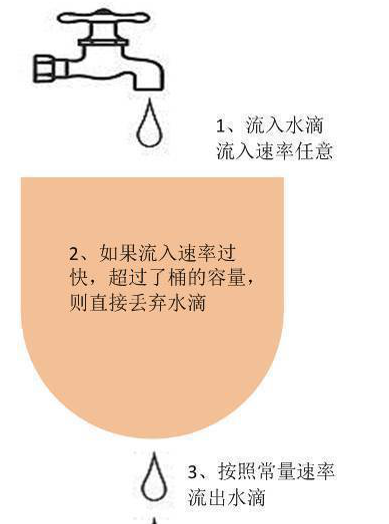 ‘
‘
水(请求)先进入到漏桶里,漏桶以一定的速度出水(接口有响应速率),
当水流入速度过大会直接溢出(访问频率超过接口响应速率), 然后就拒绝请求,
可以看出漏桶算法能强行限制数据的传输速率.
有两个变量:
- 一个是桶的大小,支持流量突发增多时可以存多少的水(burst),
- 另一个是水桶漏洞的大小(rate)。
漏桶抽象类:LeakTokenBucket,继承与令牌桶抽象父类 TokenBucket,说明了获取令牌(漏出令牌)在底层的方式是一致的,不一样的是重置令牌的方式(务必理解这一点)
using System; namespace CZ.FlowControl.Service { /// <summary> /// 漏桶 /// </summary> abstract class LeakyTokenBucket : TokenBucket { protected readonly long stepTokens; protected long ticksStepInterval; protected LeakyTokenBucket(long maxTokens, long refillInterval, int refillIntervalInMilliSeconds, long stepTokens, long stepInterval, int stepIntervalInMilliseconds) : base(maxTokens, refillInterval, refillIntervalInMilliSeconds) { this.stepTokens = stepTokens; if (stepInterval < 0) throw new ArgumentOutOfRangeException("stepInterval", "Step interval cannot be negative"); if (stepTokens < 0) throw new ArgumentOutOfRangeException("stepTokens", "Step tokens cannot be negative"); if (stepIntervalInMilliseconds <= 0) throw new ArgumentOutOfRangeException("stepIntervalInMilliseconds", "Step interval in milliseconds cannot be negative"); ticksStepInterval = TimeSpan.FromMilliseconds(stepInterval * stepIntervalInMilliseconds).Ticks; } } }
可以看出,漏桶是在令牌桶的基础上增加了二个重要的属性:这两个属性决定了重置令牌桶的方式
stepTokens:每间隔时间内漏的数量
ticksStepInterval:漏的间隔时间
举个例子:TPS 100,即每秒漏出100个Token,stepTokens =100, ticksStepInterval=1000ms
漏桶的具体实现有两种:空桶和满桶
StepDownTokenBucket 满桶:即一把将令牌桶填充满

using System; namespace CZ.FlowControl.Service { /// <summary> /// 漏桶(满桶) /// </summary> /// <remarks> /// StepDownLeakyTokenBucketStrategy resembles a bucket which has been filled with tokens at the beginning but subsequently leaks tokens at a fixed interval /// </remarks> class StepDownTokenBucket : LeakyTokenBucket { public StepDownTokenBucket(long maxTokens, long refillInterval, int refillIntervalInMilliSeconds, long stepTokens, long stepInterval, int stepIntervalInMilliseconds) : base(maxTokens, refillInterval, refillIntervalInMilliSeconds, stepTokens, stepInterval, stepIntervalInMilliseconds) { } protected override void UpdateTokens() { var currentTime = SystemTime.UtcNow.Ticks; if (currentTime >= nextRefillTime) { //set tokens to max tokens = bucketTokenCapacity; //compute next refill time nextRefillTime = currentTime + ticksRefillInterval; return; } //calculate max tokens possible till the end var timeToNextRefill = nextRefillTime - currentTime; var stepsToNextRefill = timeToNextRefill/ticksStepInterval; var maxPossibleTokens = stepsToNextRefill*stepTokens; if ((timeToNextRefill%ticksStepInterval) > 0) maxPossibleTokens += stepTokens; if (maxPossibleTokens < tokens) tokens = maxPossibleTokens; } } }
StepUpLeakyTokenBucket 空桶:即每次只将stepTokens个数的令牌放到桶中

1 using System; 2 3 namespace CZ.FlowControl.Service 4 { 5 /// <summary> 6 /// 漏桶(空桶) 7 /// </summary> 8 /// <remarks> 9 /// StepUpLeakyTokenBucketStrategy resemembles an empty bucket at the beginning but get filled will tokens over a fixed interval. 10 /// </remarks> 11 class StepUpLeakyTokenBucket : LeakyTokenBucket 12 { 13 private long lastActivityTime; 14 15 public StepUpLeakyTokenBucket(long maxTokens, long refillInterval, int refillIntervalInMilliSeconds, long stepTokens, long stepInterval, int stepIntervalInMilliseconds) 16 : base(maxTokens, refillInterval, refillIntervalInMilliSeconds, stepTokens, stepInterval, stepIntervalInMilliseconds) 17 { 18 } 19 20 protected override void UpdateTokens() 21 { 22 var currentTime = SystemTime.UtcNow.Ticks; 23 24 if (currentTime >= nextRefillTime) 25 { 26 tokens = stepTokens; 27 28 lastActivityTime = currentTime; 29 nextRefillTime = currentTime + ticksRefillInterval; 30 31 return; 32 } 33 34 //calculate tokens at current step 35 36 long elapsedTimeSinceLastActivity = currentTime - lastActivityTime; 37 long elapsedStepsSinceLastActivity = elapsedTimeSinceLastActivity / ticksStepInterval; 38 39 tokens += (elapsedStepsSinceLastActivity*stepTokens); 40 41 if (tokens > bucketTokenCapacity) tokens = bucketTokenCapacity; 42 lastActivityTime = currentTime; 43 } 44 } 45 }
三、流控服务封装
第二章节,详细介绍了令牌桶和漏桶的具体实现。基于以上,要重点介绍接口:IThrottleStrategy:流控的具体方式
using System; namespace CZ.FlowControl.Spi { /// <summary> /// 流量控制算法策略 /// </summary> public interface IThrottleStrategy { /// <summary> /// 是否流控 /// </summary> /// <param name="n"></param> /// <returns></returns> bool ShouldThrottle(long n = 1); /// <summary> /// 是否流控 /// </summary> /// <param name="n"></param> /// <param name="waitTime"></param> /// <returns></returns> bool ShouldThrottle(long n, out TimeSpan waitTime); /// <summary> /// 是否流控 /// </summary> /// <param name="waitTime"></param> /// <returns></returns> bool ShouldThrottle(out TimeSpan waitTime); /// <summary> /// 当前令牌个数 /// </summary> long CurrentTokenCount { get; } } }
有了这个流控方式接口后,我们还需要一个流控策略定义类:FlowControlStrategy
即定义具体的流控策略:以下是这个类的详细属性和成员: 不仅定义了流控策略类型,还定义了流控的维度信息和流控阈值,这样流控就做成依赖注入的方式了!
using System; using System.Collections.Generic; using System.Text; namespace CZ.FlowControl.Spi { /// <summary> /// 流控策略 /// </summary> public class FlowControlStrategy { /// <summary> /// 标识 /// </summary> public string ID { get; set; } /// <summary> /// 名称 /// </summary> public string Name { get; set; } /// <summary> /// 流控策略类型 /// </summary> public FlowControlStrategyType StrategyType { get; set; } /// <summary> /// 流控阈值-Int /// </summary> public long IntThreshold { get; set; } /// <summary> /// 流控阈值-Double /// </summary> public decimal DoubleThreshold { get; set; } /// <summary> /// 时间区间跨度 /// </summary> public FlowControlTimespan TimeSpan { get; set; } private Dictionary<string, string> flowControlConfigs; /// <summary> /// 流控维度信息 /// </summary> public Dictionary<string, string> FlowControlConfigs { get { if (flowControlConfigs == null) flowControlConfigs = new Dictionary<string, string>(); return flowControlConfigs; } set { flowControlConfigs = value; } } /// <summary> /// 描述 /// </summary> public string Descriptions { get; set; } /// <summary> /// 触发流控后是否直接拒绝请求 /// </summary> public bool IsRefusedRequest { get; set; } /// <summary> /// 创建时间 /// </summary> public DateTime CreateTime { get; set; } /// <summary> /// 创建人 /// </summary> public string Creator { get; set; } /// <summary> /// 最后修改时间 /// </summary> public DateTime LastModifyTime { get; set; } /// <summary> /// 最后修改人 /// </summary> public string LastModifier { get; set; } } }
同时,流控策略类型,我们抽象了一个枚举:FlowControlStrategyType
支持3种流控策略:TPS、Sum(指定时间段内请求的次数),Delay延迟
using System; using System.Collections.Generic; using System.Text; namespace CZ.FlowControl.Spi { /// <summary> /// 流控策略类型枚举 /// </summary> public enum FlowControlStrategyType { /// <summary> /// TPS控制策略 /// </summary> TPS, /// <summary> /// 总数控制策略 /// </summary> Sum, /// <summary> /// 延迟控制策略 /// </summary> Delay } }
面向每种流控策略类型,提供了一个对应的流控器,比如说TPS的流控器
TPSFlowController,内部使用了固定令牌桶算法
using System; namespace CZ.FlowControl.Service { using CZ.FlowControl.Spi; /// <summary> /// TPS流量控制器 /// </summary> class TPSFlowController : IFlowController { public IThrottleStrategy InnerThrottleStrategy { get; private set; } public FlowControlStrategy FlowControlStrategy { get; private set; } public bool ShouldThrottle(long n, out TimeSpan waitTime) { return InnerThrottleStrategy.ShouldThrottle(n, out waitTime); } public TPSFlowController(FlowControlStrategy strategy) { FlowControlStrategy = strategy; InnerThrottleStrategy = new FixedTokenBucket(strategy.IntThreshold, 1, 1000); } } }
Sum(指定时间段内请求的次数)流控器:
using System; using System.Collections.Generic; using System.IO; using System.Linq; using System.Text; namespace CZ.FlowControl.Service { using CZ.FlowControl.Spi; /// <summary> /// 一段时间内合计值流量控制器 /// </summary> class SumFlowController : IFlowController { public IThrottleStrategy InnerThrottleStrategy { get; private set; } public FlowControlStrategy FlowControlStrategy { get; private set; } public bool ShouldThrottle(long n, out TimeSpan waitTime) { return InnerThrottleStrategy.ShouldThrottle(n, out waitTime); } public SumFlowController(FlowControlStrategy strategy) { FlowControlStrategy = strategy; var refillInterval = GetTokenBucketRefillInterval(strategy); InnerThrottleStrategy = new FixedTokenBucket(strategy.IntThreshold, refillInterval, 1000); } private long GetTokenBucketRefillInterval(FlowControlStrategy strategy) { long refillInterval = 0; switch (strategy.TimeSpan) { case FlowControlTimespan.Second: refillInterval = 1; break; case FlowControlTimespan.Minute: refillInterval = 60; break; case FlowControlTimespan.Hour: refillInterval = 60 * 60; break; case FlowControlTimespan.Day: refillInterval = 24 * 60 * 60; break; } return refillInterval; } } }
同时,通过一个创建者工厂,根据不同的流控策略,创建对应的流控器(做了一层缓存,性能更好):
using System; using System.Collections.Generic; using System.Text; namespace CZ.FlowControl.Service { using CZ.FlowControl.Spi; /// <summary> /// 流控策略工厂 /// </summary> class FlowControllerFactory { private static Dictionary<string, IFlowController> fcControllers; private static object syncObj = new object(); private static FlowControllerFactory instance; private FlowControllerFactory() { fcControllers = new Dictionary<string, IFlowController>(); } public static FlowControllerFactory GetInstance() { if (instance == null) { lock (syncObj) { if (instance == null) { instance = new FlowControllerFactory(); } } } return instance; } public IFlowController GetOrCreateFlowController(FlowControlStrategy strategy) { if (strategy == null) throw new ArgumentNullException("FlowControllerFactory.GetOrCreateFlowController.strategy"); if (!fcControllers.ContainsKey(strategy.ID)) { lock (syncObj) { if (!fcControllers.ContainsKey(strategy.ID)) { var fcController = CreateFlowController(strategy); if (fcController != null) fcControllers.Add(strategy.ID, fcController); } } } if (fcControllers.ContainsKey(strategy.ID)) { var controller = fcControllers[strategy.ID]; return controller; } return null; } private IFlowController CreateFlowController(FlowControlStrategy strategy) { if (strategy == null) throw new ArgumentNullException("FlowControllerFactory.CreateFlowController.strategy"); IFlowController controller = null; switch (strategy.StrategyType) { case FlowControlStrategyType.TPS: controller = new TPSFlowController(strategy); break; case FlowControlStrategyType.Delay: controller = new DelayFlowController(strategy); break; case FlowControlStrategyType.Sum: controller = new SumFlowController(strategy); break; default: break; } return controller; } } }
有了流控策略定义、我们更进一步,继续封装了流控Facade服务,这样把流控的变化封装到内部。对外只提供流控服务接口,流控时动态传入流控策略和流控个数:FlowControlService
using System; using System.Collections.Generic; using System.Text; namespace CZ.FlowControl.Service { using CZ.FlowControl.Spi; using System.Threading; /// <summary> /// 统一流控服务 /// </summary> public class FlowControlService { /// <summary> /// 流控 /// </summary> /// <param name="strategy">流控策略</param> /// <param name="count">请求次数</param> public static void FlowControl(FlowControlStrategy strategy, int count = 1) { var controller = FlowControllerFactory.GetInstance().GetOrCreateFlowController(strategy); TimeSpan waitTimespan = TimeSpan.Zero; var result = controller.ShouldThrottle(count, out waitTimespan); if (result) { if (strategy.IsRefusedRequest == false && waitTimespan != TimeSpan.Zero) { WaitForAvailable(strategy, controller, waitTimespan, count); } else if (strategy.IsRefusedRequest) { throw new Exception("触发流控!"); } } } /// <summary> /// 等待可用 /// </summary> /// <param name="strategy">流控策略</param> /// <param name="controller">流控器</param> /// <param name="waitTimespan">等待时间</param> /// <param name="count">请求次数</param> private static void WaitForAvailable(FlowControlStrategy strategy, IFlowController controller, TimeSpan waitTimespan, int count) { var timespan = waitTimespan; if (strategy.StrategyType == FlowControlStrategyType.Delay) { Thread.Sleep(timespan); return; } while (controller.ShouldThrottle(count, out timespan)) { Thread.Sleep(timespan); } } } }
以上,统一流控服务完成了第一个版本的封装。接下来我们看示例代码
四、示例代码
先安装Nuget:
Install-Package CZ.FlowControl.Service -Version 1.0.0
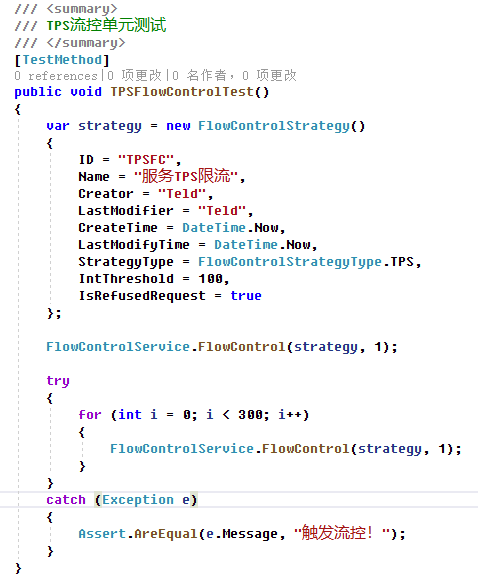
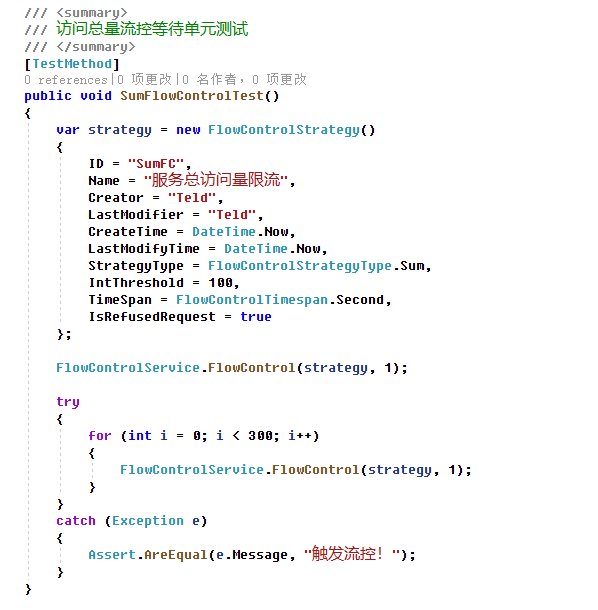
是不是很简单。
大家如果希望了解详细的代码,请参考这个项目的GitHub地址:
https://github.com/zhouguoqing/FlowControl
同时也欢迎大家一起改进完善。
周国庆
2019/8/9




 浙公网安备 33010602011771号
浙公网安备 33010602011771号